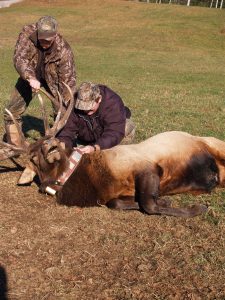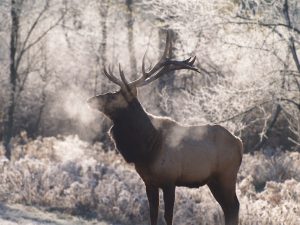
PART 2 JOE AND THE ELK by BARNEY MOORHOUSE
Many folk have a bird feeder or two and are quite content to enjoy a cup of tea while watching the birds flock to the feed which, for the most part, provides relatively inexpensive entertainment. Then there is The Elkman.
In 2002, Joe was spending $1000.00 of his own money for 500 bales of second cut alfalfa plus the added cost of oats, block salt and apples. None of this included the cost of actually getting the feed. “There were 13 elk and 14 deer here,” he told me during a visit.
One deer, “Pinky” for her pink nose, had been coming to Joe’s for 17 years. “This was the first year that she didn’t have twins.” Joe never imagined that elk would be re-introduced to the area. “Especially when you hear it costs about $10,000 an animal,” he added.
“Deer are sloppy eaters, whereas elk eat up everything,” said Joe. “They’re like a vacuum cleaner.” Concerned that the elk may be shot during the deer season Joe provided the Ministry of Natural Resources with photos for inclusion in the provincial Hunting Regs to help hunters identify them as, at that time, there was no elk season.
From 2000 to 2005, 17 of 29 elk that died near Bancroft were infected with brainworm according to post mortem studies.
Since The Elkman began feeding the elk many visitors have dropped by to see and hear all that there is for Joe has much to say about his beloved charges. Newspaper reporters, magazine writers, television reporters and classes of students have all made their way to Joe’s. Which, by the way, is well away from any roadway. Rolly Ethier, a reporter for the Campbellford Courier, once called Joe “a real-life Dr. Doolittle,” a gentle and knowledgeable man who not only talks to the elk but feeds them during the winter. Locally known as the Hartsmere herd, near McArthur’s Mills, Ontario, the reporter heard The Elkman whispering to them in Austrian. “Do they actually understand you?” he asked. “Because I didn’t realize these elk were Austrian.”
Sadly, as their 50th wedding anniversary approached, doctors discovered that Edith, Joe’s wife, was battling cancer. It proved to be a quick losing battle. In short order Joe sold their chalet and moved to a nearby two bedroom cottage, a former hunt camp, located on 2000 acres where he would act as overseer for the landowner. The move proved to be a boon for the MNR’s elk studies.
When the Ontario government cut elk research funding the Quinte Elk Restoration Committee (QERC) , a group of volunteers, jumped in and raised significant funding that not only helped pay for the feed but helped the MNR purchase GPS collars (@$4500.00) and contributed to the aerial helicopter surveys (@$1075.00 per hour.) Joe’s constant presence and observation contributed much to the ministry’s knowledge of the elk. His videos and photographs also augmented the studies. On one occasion, Dr. Rick Rosatte, who headed up the elk program, told a reporter, perhaps with a sense of humility, that “he (Joe) probably knows more about elk than I do.” Little can compare to on site observation, 24/7.
For example, on October 5, 2004, Joe photographed a recently born male elk. Birthing normally occurs sometime in mid-May to early July. Dr. Rosatte calculated that the calf was conceived between late December 2003 and early January 2004. With winter imminent the calf’s chances of survival were not optimal. This calf was born to an 11 year old cow, ear tag #347, whose age and inability to meet the annual energy requirements necessary for normal reproduction may have contributed to the late conception and birth. It appears that the still spotted calf was killed by a mature bull elk on February 25, 2005.
GPS collars record the travels and daily pattern of the elk. To-day, researchers can sit at their computer, call up the appropriate satellite signal, and see where the collared elk are located.
When the ministry wanted to collar 6 animals they just had to go to Joe’s instead of having to search for the animals, often under less than ideal circumstances and no assurance of success.
In December 2005, the Rocky Mountain Elk Foundation (RMEF), which had been an integral part of the elk re-introduction, announced that it was leaving Canada. The QERC quickly reacted, incorporated as a charitable organization and undertook to fill the RMEF vacancy. The RMEF used to send a significant percentage of the funds raised by the QERC to the U.S. Effectively that stopped with the RMEF’s departure and 100% of the funds raised by the QERC were dispersed locally for education, feed and research.
In 2011 the Ministry of Natural Resources organized Ontario’s first elk hunt since 1979. Until that time, hunters were permitted to take an elk on their deer licence. In fact, Richard Sloat shot the last recorded legally hunted elk, a bull, on November 2, 1970.
The 2011 MNR hunt was for one week in September. The Algonquins of Ontario (AOO) also organized a native hunt that ran from September 1, 2011 to January 15, 2012. In 2012, the MNR hunt expanded to two weeks and the AOO continued as in 2011. For the 2014 elk hunt the AOO, in consultation with the MNR, shortened its hunt to run September 1 to December 21, 2014. In 2014, the ministry and the AOO reduced the number of bull tags due to concerns that too many prime breeders were being eliminated.
May 2, 2014, the QERC hosted its last fund raising dinner. Since its first dinner, April 2001, it contributed over $200,000 to the cause, “most of which has been spent in direct support of elk in the Bancroft area,” said Treasurer Doug Howell. The committee believes that it has sufficient funds to contribute for another 3-4 years.
In the meantime Joe “The Elkman” continues to watch over the Hartsmere Herd and like a devoted steward he is always happy to chat and extol the virtues of elk.
